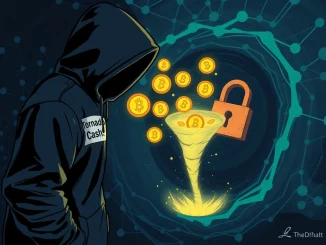
The world of cryptocurrency promises innovation and financial freedom, but it also presents significant challenges, particularly concerning security and illicit activities. Recent reports paint a concerning picture: crypto crime is on the rise, fueled by a perceived lack of effective oversight and enforcement.
Why is Crypto Crime Surging? Understanding the Regulatory Gap
Experts point to a clear cause for the uptick in illicit crypto activities: a void in regulatory oversight. Cointelegraph reported that factors like politicians promoting memecoins, lax enforcement efforts, and the U.S. dropping several crypto-related lawsuits contribute to what some are calling a “crypto crime supercycle.” This environment emboldens bad actors, making it easier and less risky to engage in fraudulent schemes.
Blockchain investigator ZachXBT has warned that the absence of strong regulatory frameworks allows influencers to scam their followers with minimal consequences. This creates a breeding ground for deception, where trust is easily exploited for financial gain.
The Many Faces of Crypto Scams and Threats
The increase in crypto crime manifests in various forms, impacting users across the ecosystem. The first quarter of the year alone saw over $2 billion in losses attributed to these illicit activities. Common threats include:
- Phishing Attacks: Criminals attempt to steal private keys or login information by impersonating legitimate services or individuals.
- Black Hat Hacking: Exploiting vulnerabilities in protocols, exchanges, or smart contracts to steal funds.
- Rug Pulls: Developers of a project suddenly abandon it, taking all the invested funds with them. This is particularly common with new tokens, including some memecoins.
Taylor Monahan, lead security researcher at crypto wallet MetaMask, highlights the low-risk, high-reward nature of crypto fraud. Scammers face minimal legal, financial, or social repercussions compared to traditional crime. This profitability makes the space an attractive target for malicious actors.
The Impact on Cryptocurrency Risks and Users
The surge in crypto scams and other illicit activities significantly increases the overall cryptocurrency risks for investors and users. Beyond direct financial losses, these crimes erode trust in the technology and the market. This lack of trust can hinder mainstream adoption and attract negative attention from traditional financial systems and governments.
The interconnectedness of the crypto world means that a breach or scam in one area can have ripple effects. For instance, ransomware groups increasingly demand payment in cryptocurrency, a trend Taylor Monahan noted would be severely impacted if crypto were to disappear, indicating the deep ties between illicit activities and the digital asset space.
The Urgent Need for Crypto Regulation
The current environment underscores the critical need for clear and enforceable crypto regulation. While the crypto community often values decentralization and minimal intervention, the scale of crime indicates that some level of oversight is necessary to protect consumers and legitimate businesses. Effective regulation could:
- Establish clear rules for exchanges and service providers.
- Provide legal recourse for victims of fraud.
- Increase accountability for project developers and promoters.
- Help differentiate legitimate projects from fraudulent ones.
However, crafting effective crypto regulation is complex. Regulators must balance consumer protection with fostering innovation, avoiding overly burdensome rules that could stifle growth or push activity underground.
Enhancing Blockchain Security: A Collective Effort
While regulation is debated and developed, enhancing blockchain security remains paramount. This involves efforts from multiple parties:
- Developers: Building secure protocols and smart contracts, conducting audits.
- Exchanges and Wallets: Implementing robust security measures, offering user education, and responding quickly to threats.
- Users: Practicing vigilance, using strong passwords, enabling two-factor authentication, and being skeptical of unsolicited offers or promotions.
The underlying technology of blockchain offers inherent security features like transparency and immutability. However, vulnerabilities often lie in the layers built *on top* of the blockchain, such as smart contract code, user interfaces, or centralized exchange infrastructure. Focusing on security best practices at all levels is vital.
Protecting Yourself from Cryptocurrency Risks
Given the current landscape, individual vigilance is your first line of defense against cryptocurrency risks and scams. Here are some actionable steps:
- Do Your Own Research (DYOR): Never invest based solely on influencer recommendations or hype. Understand the project, its team, and its technology.
- Be Wary of Promises: High, guaranteed returns are a major red flag for pyramid or Ponzi schemes.
- Secure Your Keys: Use hardware wallets for significant holdings. Never share your private keys or seed phrase.
- Enable 2FA: Use two-factor authentication on all your crypto accounts.
- Verify Sources: Double-check URLs and email addresses to avoid phishing sites.
- Understand Smart Contracts: Be cautious when interacting with unaudited or complex smart contracts.
Staying informed about common scam techniques is crucial in navigating the market safely.
Conclusion: Addressing the Crypto Crime Challenge
The current surge in crypto crime is a significant challenge for the entire cryptocurrency ecosystem. It is not just a technical issue but one deeply rooted in the lack of clear rules and enforcement. While the decentralized nature of crypto offers benefits, the absence of traditional gatekeepers has unfortunately created fertile ground for fraud and theft.
Addressing this requires a multi-pronged approach: thoughtful and effective crypto regulation, continuous improvements in blockchain security by developers and platforms, and increased awareness and caution among users facing cryptocurrency risks. Until these measures are robustly implemented, the shadow of crime will continue to impact the growth and reputation of the digital asset space.



